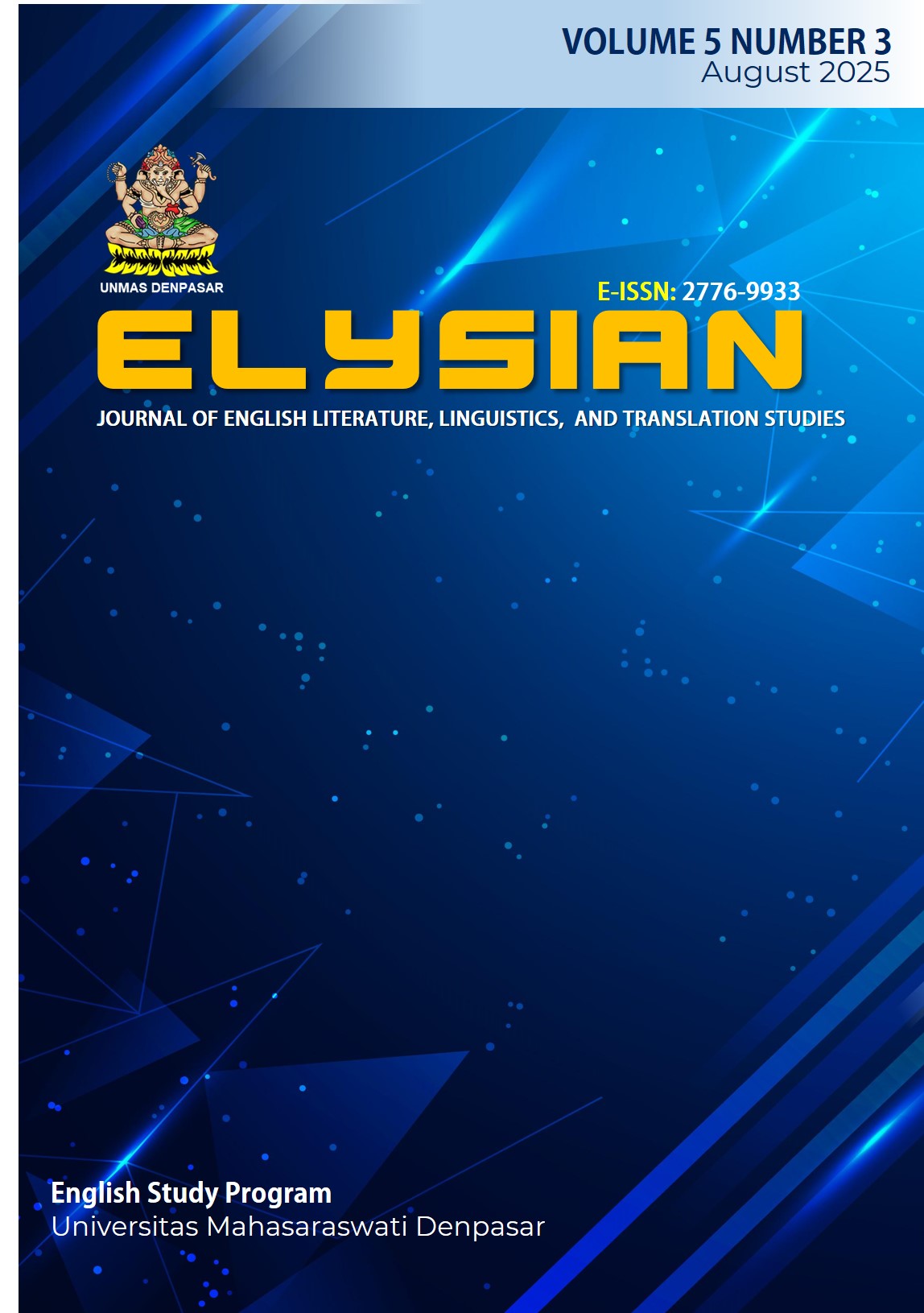Analysis of Prefixes in the Novel Always Forever Maybe
DOI:
https://doi.org/10.36733/elysian.v5i3.12302Keywords:
prefixation, derivational morphology, semantic function, literary linguistics, narrative structureAbstract
This study investigated the semantic functions of English prefixation in Anica Mrose Rissi’s
novel Always Forever Maybe. It employed a qualitative descriptive approach and analyzed
five prefixed lexical items (rename, disintegrate, overblown, Outbid, and unintelligible) to
examine how prefixation contributed to emotional tone, character development, and thematic
depth. Data were gathered through close reading and were analysed morphologically using the
frameworks of Katamba (1993) and Lieber (2009). In addition, the data were analysed by using
a combination of labelled analysis, bracketing, and tree diagram techniques. The findings
revealed that prefixes functioned as semantic modifiers without altering the grammatical class
of the base words. They fulfilled conceptual roles such as reversal, directionality, intensity,
and spatial relation. Unlike previous studies that addressed affixation more broadly, this
research offered a focused perspective on the narrative utility of prefixation in literary
discourse. The analysis of these prefixed words revealed that they serve as subtle yet impactful
linguistic tools, enhancing literary expression by adding layers of meaning to the narrative,
deepening character portrayals, and enriching thematic resonance. The study concludes that
prefixation is a significant contributor to the overall literary and emotional impact of the novel.
References
References
Agustina, V., & Anam, S. (2019). The expressive function of affixation in English short stories: Focusing on prefix usage.
Aronoff, M., & Fudeman, K. (2011). What is Morphology? (2nd ed.). Wiley-Blackwell.
Bauer, L. (2003). Introducing Linguistic Morphology (2nd ed.). Edinburgh University Press.
Booij, G. (2007). The Grammar of Words: An Introduction to Linguistic Morphology (2nd ed.). Oxford University Press.
Carstairs-McCarthy, A. (2002). An Introduction to English Morphology: Words and Their Structure. Edinburgh University Press.
Danti, A., & Budianto, L. (2022). The use of English prefixes in academic texts and their semantic functions. Linguistics and Language Teaching Journal, 5(2), 87–96.
Katamba, F. (1993). Morphology. London: Macmillan Press.
Kennedy, G. (2003). Structure and Meaning in English: A Guide for Teachers. London: Routledge.
Lieber, R. (2009). Introducing Morphology. Cambridge University Press.
Matthews, P. H. (1991). Morphology (2nd ed.). Cambridge University Press.
Nurjanah, S., & Putri, N. S. (2020). Morphological features in young adult fiction: A study on derivational affixes and emotional representation.
Plag, I. (2003). Word-Formation in English. Cambridge University Press.
Rahmatiah, R. (2023). Derivational and inflectional morphology in the novel Kata by Rintik Sedu* [Undergraduate thesis, Hasanuddin University]. https://repository.unhas.ac.id/id/eprint/31555
Rissi, A. M. (2018). Always Forever Maybe. New York: HarperTeen.
Rizqieyanti, I., Nurdiana, N., & Mawaddah, U. (2023). Affixation in the novel Tenggelamnya Kapal Van Der Wijck by Hamka. ALEGORI: Journal of Educational Studies, 18(1), 1–10. https://jim.unindra.ac.id/index.php/alegori/article/view/9391
Setiari, L. M., Sumarwati, S., & Suwandi, S. (2021). Derivational affixes in Indonesian short stories and their narrative role. BASASTRA: Journal of Indonesian Language and Literature Studies, 10(1), 56–65.
Yule, G. (2010). The Study of Language (4th ed.). Cambridge University Press.
Yunita, D. (2023). Derivational morphology in contemporary Indonesian literature: A semantic perspective. Journal of Indonesian Language and Literary Studies, 8(1), 23–34.








